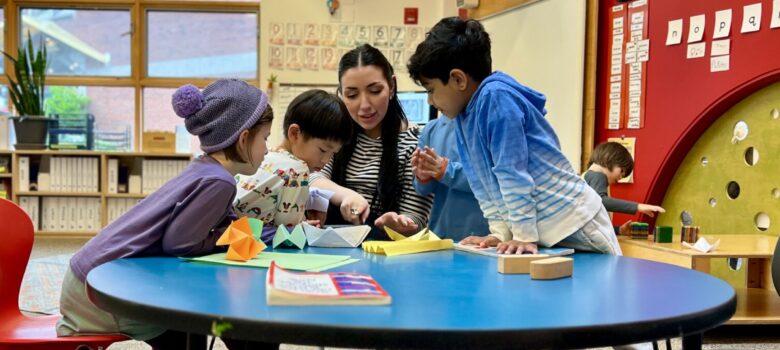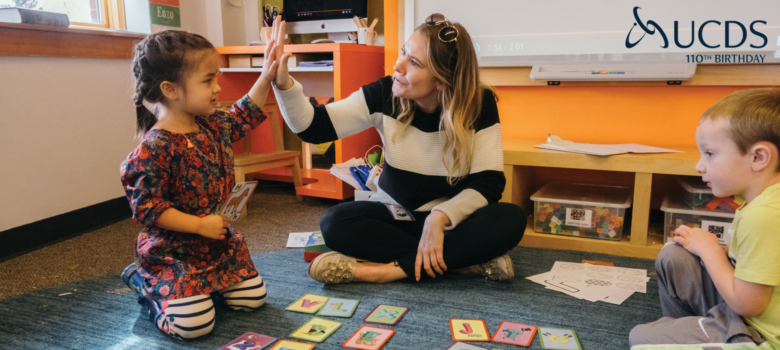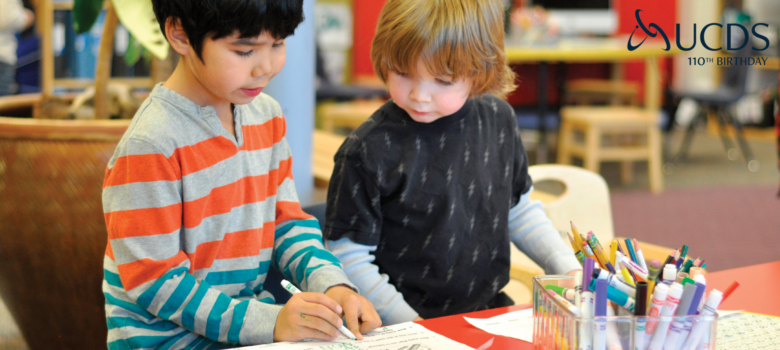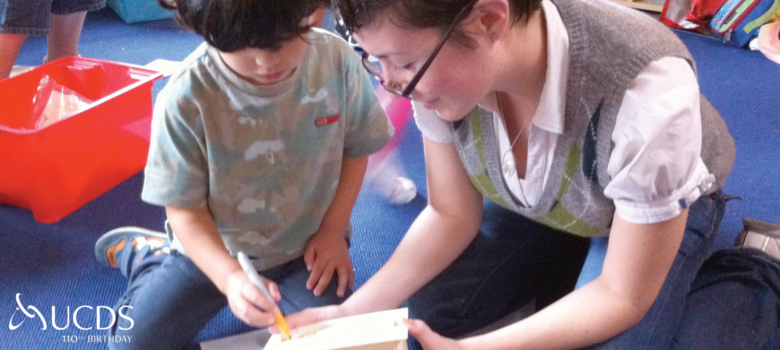Infant teacher Marianne Sardelich returns to share the magic in the development of young children. -Ed.
– – – –
There is something extraordinary about the time between a child turning one year old and two years old. What makes this age so magical? Have you ever watched a one year old look at something as everyday as a leaf? The child tentatively approaches it, and bends down to get a closer look. With deep concentration, they reach out to touch the leaf. If the touch is pleasing, then the child picks it up and holds it out in front of their eyes so that they can thoroughly inspect it. After examining it, they might offer the leaf to someone else or they might crumble it in their hands and watch the pieces drop to the ground. Then they might point to a tree and notice all the other leaves that haven’t fallen yet. Watching a one year old do this might make you as an adult wonder, “When did I last look at something so closely?”
During the first twelve months of life, infants explore the world in relation to themselves. The question on their minds is: “What happens when I do this?” This approach applies to both their investigations of objects and people. Jean Piajet called this the Sensorimotor Stage. Babies manipulate objects to produce satisfying sensations like batting at a toy or smiling at mom who also smiles back. By doing this they develop their vision, coordination, and begin to cultivate a sense of logic. As babies move closer to one, their view of the world becomes more expansive and they begin to wonder how things relate to each other. (Berger 2015)
Between 12 and 18 months old, a child is in the Tertiary Circular Stage. They are curious about everything that is going on around them and wonder what those things can do and how they can use different items (and people) to achieve their own goals. Their actions are goal-directed and purposeful and they are becoming more complex. These more involved actions are fueled by their curiosity and their desire to test their theories about the world around them. “Their research method is trial and error. Their devotion to discovery is familiar to every adult scientist.” (Berger 2015)
At the same time that they are testing theories about materials, they are also beginning to develop their ability to play with another child. Infants play alongside one another. Each is doing something independently and while they might watch one another or reach out to take the other’s material, they are not quite ready to collaborate. One year olds watching other children play wonder how they can join the game or how they can start a new game. We see this every year in our infant toddler classroom when the peek-a-boo game develops. It starts between teachers and children and then the one year olds take the game over. A one year old hides behind a curtain or underneath a scarf and invites other one year olds to find them by giggling, yelling, or popping out to remind their friends where they are.
The magical piece of all of this theory testing and collaborative play is that it is all new. When a one year old drops a ball off the top of the loft, they don’t know that it will always fall to the ground. When a one year old hands a toy to a friend, they will probably be genuinely surprised when the friend takes it and doesn’t want to give it back. All of their theory testing and new discoveries create an internal schema within the child of what they understand to be true in the world around them.
At the moment, my interest in one-year olds is heightened because I currently have one living at my house. My son Patrick is 18 months old and everyday (despite my experience with young children and probably because this one is mine), I am amazed at the amount that he is processing about the world around him and how he shares his understanding with me through his words and actions. My current favorite example of this is his favorite question: Where did he go? This is said as though it is one word and all in one breath “WhereEgooo?” But with a lot of emphasis on the question at the end. This question applies to almost anything that Patrick wonders about. Where is Daddy? Are we going to school? Why is my friend going to the top of the loft while I am still at the table? When you answer and he understands your answer, he usually says “Ohhh”. If he doesn’t understand, he asks the question again “WhereEgooo?” and perhaps pointing to something to help us get the hint about what he is really asking about. This is how Patrick is learning to make sense of the world by asking questions, listening to answers, and if he doesn’t understand the answer, asking the question again. He adjusts how he communicates to better hone in on what he wants you to answer. He has only been on the planet for 18 months and he already understand the basics of scientific theory. One year olds are remarkable.
“The Developing Person” Through Childhood by Kathleen Stassen Berger. 7th Edition. Published by Worth Publishers in 2015




